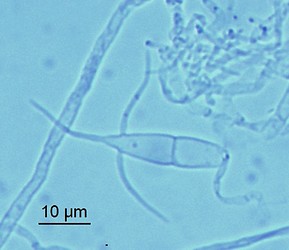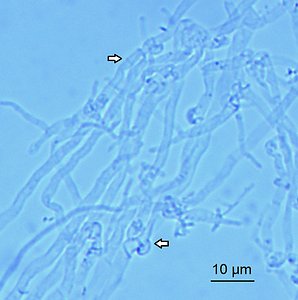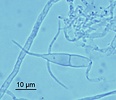Classiculomycetes
Classicula
Classiculales
Merje Toome and M. Catherine AimeIntroduction
This class contains a single order, Classiculales, for which only two species are known, both isolated from freshwater habitats. These two aquatic fungi are Classicula fluitans (anamorph Naiadella fluitans) and Jaculispora submersa (teleomorph unknown) (Hudson and Ingold 1960; Marvanova and Bandoni 1987). Morphologically these species are rather well studied, but very little is known of their ecology or whether they are entirely aquatic. Classicula fluitans (originally isolated from aquatic leaf litter) has been shown to parasitize its own hyphae in culture, making it likely that this species is a mycoparasite (Bauer et al. 2003). Plant host preferences have been tested for J. submersa, which suggest an affinity for oak leaves (Prokhorov and Bodyagin 2007).
Characteristics
As is true for all Pucciniomycotina, the members of this class have simple septal pores. In both C. fluitans and J. submersa these are surrounded by microbodies that are arranged in a circular pattern. Another characteristic feature is the production of tremelloid haustorial cells, such as are commonly found in mycoparasitic fungi. This provides further evidence that these species have mycoparasitic abilities (Bauer et al. 2003). Although these characteristics can be separately found in members of many other Pucciniomycotina groups, the combination of binucleate tremelloid haustorial cells and pore-associated microbodies to date is known only in Classiculales.
Both species are hyphal with hyaline cells and may form adventitious septa in addition to primary septa. While primary septa are formed in association with nuclear division and have clamp connections, adventitious septa are clampless and form independent of nuclear division (Figure 1). Asexual reproduction takes place via conidia which have broadly diverging subapical branches (see title illustration). These resemble the conidia of some other unrelated aquatic fungi (Marvanova and Bandoni 1987). The sexual stage of C. fluitans has been observed to occur only on the water surface. The basidia occur in clusters, are transversely divided by three septal walls and have subapically swollen sterigmata, the last of which is unique in Pucciniomycotina. The basidiospores are small and elongate (1.5–2 × 20–40 µm), which is also a common character among other unrelated aquatic fungi (Bauer et al. 2003). No teleomorphic state is known for J. submersa.
Discussion of Phylogenetic Relationships
Morphological and sequence data clearly show that C. fluitans and J. submersa form a separate class in Pucciniomycotina (Bauer et al. 2003; 2006; Aime et al. 2006). However, the phylogenetic relationships between Classiculomycetes and other rust allies still remain to be resolved.
References
Aime, M. C., P. B. Matheny, D. A. Henk, E. M. Frieders, R. H. Nilsson, M. Piepenbring, D. J. McLaughlin, L. J. Szabo, D. Begerow, J. P. Sampaio, R. Bauer, M. Weiß, F. Oberwinkler, and D. S. Hibbett. 2006. An overview of the higher-level classification of Pucciniomycotina based on combined analyses of nuclear large and small subunit rDNA sequences. Mycologia 98: 896–905.
Bauer, R., Begerow, D., Oberwinkler, F., Marvanova, L. 2003. Classicula: the teleomorph of Naiadella fluitans. Mycologia 95: 756-764.
Bauer, R., Begerow, D., Sampaio, J., Weiβ, M., Oberwinkler, F. 2006. The simple-septate basidiomycetes: a synopsis. Mycological Progress 5: 41-66.
Hudson, H.J., Ingold, C.T. 1960. Aquatic hyphomycetes from Jamaica. Transactions of the British Mycological Society 43: 469-478.
Marvanova, L., Bandoni, R. J. 1987. Naiadella fluitans gen. et sp. nov.: a conidial basidiomycete. Mycologia 79: 578-586.
Prokhorov, V., Bodyagin, V. 2007. The ecology of aero-aquatic hyphomycetes. Moscow University Biological Sciences Bulletin 62: 15-20.
Title Illustrations

| Scientific Name | Classicula fluitans |
|---|---|
| Comments | Asexual spore of Classicula fluitans |
| Specimen Condition | Live Specimen |
| Life Cycle Stage | asexual |
| Image Use |
 This media file is licensed under the Creative Commons Attribution-NonCommercial License - Version 3.0. This media file is licensed under the Creative Commons Attribution-NonCommercial License - Version 3.0.
|
| Copyright |
© 2012

|
About This Page
Development of this page was facilitated by the "Deep Hypha" Research Coordination Network and the "Assembling the Fungal Tree of Life" project (NSF award DEB-0732968).
M. Catherine Aime

Louisiana State University Agricultural Center
Correspondence regarding this page should be directed to Merje Toome at and M. Catherine Aime at
Page copyright © 2012 and M. Catherine Aime
 Page: Tree of Life
Classiculomycetes. Classicula. Classiculales.
Authored by
Merje Toome and M. Catherine Aime.
The TEXT of this page is licensed under the
Creative Commons Attribution-NonCommercial License - Version 3.0. Note that images and other media
featured on this page are each governed by their own license, and they may or may not be available
for reuse. Click on an image or a media link to access the media data window, which provides the
relevant licensing information. For the general terms and conditions of ToL material reuse and
redistribution, please see the Tree of Life Copyright
Policies.
Page: Tree of Life
Classiculomycetes. Classicula. Classiculales.
Authored by
Merje Toome and M. Catherine Aime.
The TEXT of this page is licensed under the
Creative Commons Attribution-NonCommercial License - Version 3.0. Note that images and other media
featured on this page are each governed by their own license, and they may or may not be available
for reuse. Click on an image or a media link to access the media data window, which provides the
relevant licensing information. For the general terms and conditions of ToL material reuse and
redistribution, please see the Tree of Life Copyright
Policies.
- First online 21 February 2008
- Content changed 30 January 2012
Citing this page:
Toome, Merje and M. Catherine Aime. 2012. Classiculomycetes. Classicula. Classiculales. Version 30 January 2012 (under construction). http://tolweb.org/Classicula/52262/2012.01.30 in The Tree of Life Web Project, http://tolweb.org/









 Go to quick links
Go to quick search
Go to navigation for this section of the ToL site
Go to detailed links for the ToL site
Go to quick links
Go to quick search
Go to navigation for this section of the ToL site
Go to detailed links for the ToL site